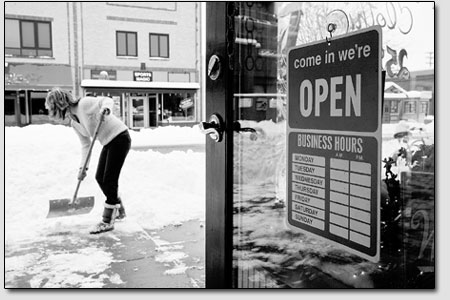|
| ||
| Staying in business SideStory: Seven directives for downtown Durango
by Will Sands Downtown Durango has received the results of a first-ever check-up. Indicators point to a downtown business district that is healthy and has successfully bucked the national trend that has buried moms and pops beneath big boxes. However, the news is not all rosy. Without support, the business district’s core may not remain healthy and viable in the years to come. Downtown Durango is a community asset that needs no explanation. Keeping this core viable and financially healthy is the sole mission of the Business Improvement District. To this end, BID retained a consulting team to take the pulse of downtown and identify areas where there’s room for improvement. “We really haven’t ever done an economic analysis of downtown,” said Jasper Welch, coordinator for the BID board. “With this assessment, the downtown community wanted to step back and take a look at what makes the core of Durango function. The study included identification of economic trends and user groups, an analysis of resident and tourist economic impacts, and a look at sales “leakage.” RRC Associates, a Boulder-based firm focused on community and land planning, revealed its findings last week. The good news is that downtown Durango, which includes the historic downtown as well as North Main, is in relatively good shape. “The assessment showed general strength and community support for downtown,” Welch explained. “Downtown has held its own during the last six years, a period where south Durango has seen substantial growth.” According to the findings, downtown accounted for 49 percent of Durango’s total sales and saw modest growth between 2002 and 2008. What’s significant is that several big box retailers either came on line or hit their stride during the same period. John Wells, BID’s presiding officer, added that “holding its own” perfectly describes the current downtown climate. Though there has been growth in recent years, accounting for inflation tells a different story. “There has been sales growth over the period, but it’s more or less flat after you adjust for inflation,” Wells said. “It’s not like we’re in a bad place. The downtown is healthy. But clearly you want to see growth when you’re talking about commerce.” Shifting the downtown picture from flat to growth is a crucial piece of the assessment, according to Wells. “The real purpose of this study is to identify some niches and opportunities that are under-utilized today,” he said. To get there, RRC Associates took a hard look at the influence of residents and tourists on downtown business. Through a variety of surveys, the firm determined that tourists do outspend locals. The average tourist spends approximately $91 per day in downtown. Locals, by comparison, drop an average of $30 per visit to the historic district. However, locals also account for far more downtown business traffic. “It’s kind of a toss up,” Wells said. “The visitors were clearly outspending the locals, but year-round we have fewer tourist visits than local visits.” Welch added that this dichotomy is crucial to the mix that has made the downtown business district viable. “In Durango we have a base core of customers so we don’t ever have to rely on a purely tourist economy,” he said. In general, RRC Associates called on Durango to preserve and improve the mix that has made downtown what it is. A key principle of the plan is to “keep downtown authentic, a place that belongs to locals while being attractive to visitors.” With permanent residences, government and private offices and retail and restaurants all playing into this authenticity, Welch noted that a multi-pronged approach will be necessary. “We have to maintain the proper mix,” he said. “We really need all the pieces to have a successful downtown.” Access is the both leading asset and top need for downtown Durango, according to RRC Associates. The study cited availability of parking as a major shortfall for downtown and suggested a parking garage could alleviate some of the strain. However, the surveys also turned up a few surprises in the access department. Twenty-three percent of consumers walk downtown, and 10 percent of residents and tourists ride their bikes. “This tells us that we need to accommodate more than vehicular traffic,” Welch said. “We need to improve the pedestrian friendliness and bikeability of downtown.” Now that the assessment is complete, the BID and RRC Associates are putting theory into practice. In coming months, they will come up with concrete steps and strategies for maintaining and improving the downtown climate. Welch concluded that the stakes are high, and they will be moving forward carefully and diligently. “How the downtown goes is really critical to the future of Durango,” he said. “If downtown business actually slides, that’s not going to be good for anyone.”
|


